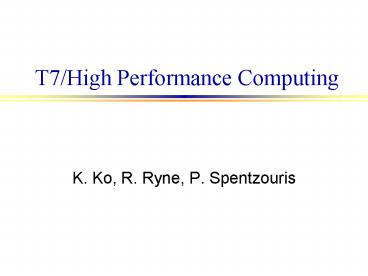T7/High Performance Computing PowerPoint PPT Presentation
1 / 19
Title: T7/High Performance Computing
1
T7/High Performance Computing
- K. Ko, R. Ryne, P. Spentzouris
2
Accelerators are Crucial to Scientific
Discoveries in High Energy Physics, Nuclear
Physics, Materials Science, Biological Science
Starting this fall, a machine called RHIC will
collide gold nuclei with such force that they
will melt into their primordial building blocks
A new generation of accelerators capable of
generating beams of exotic radioactive nuclei
aims to simulate the element-building process in
stars and shed light on nuclear structure
Muon Experiment Challenges Reigning Model of
Particles
Violated particles reveal quirks of antimatter
Biologists and other researchers are lining up
at synchrotrons to probe materials and molecules
with hard x-rays
3
Contributions of accelerators to applied science
and tech have huge economic impact and greatly
benefit society
- Medical isotope production
- Electron microscopy
- Accelerator mass spectrometry
- Medical irradiation therapy
- Ion implantation
- Beam lithography
- Transmutation of waste
- Accelerator-driven energy production
4
Particle accelerators are among the largest, most
complex, and most important scientific
instruments in the world
Particle accelerators helped enable some of the
most remarkable discoveries of the 20th century
(century of physics)
We may now be on the brink of revolutionary
advances in particle physics that will change how
we view the universe
- Given the complexity and importance of
accelerators, it is imperative that the most
advanced HPC tools be brought to bear on their
design, optimization, commissioning, and operation
5
Objective of HPC Working Group
- understand the modeling needs of current and
future accelerator technology - identify HPC hardware and software technologies
required for such modeling - outline a plan for the development of these
technologies
6
T7 Sessions
- Dedicated
- HPC tools
- HPC simulation of Beam Systems
- HPC simulation of Electromagnetic Systems
- Joint
- Advanced Accelerators
- Beam Dynamics
- Proton Drivers
- Muon-based Systems
- Particle Sources
7
HPC needs of present and next-generation
accelerators
8
High-Intensity Proton Drivers
- Present codes inadequate for full 3D modeling
- Extrapolation predicts year long jobs on 128
processors - Good progress from SNS effort
- Important physics
- 3D space charge
- Long bunches
- Impedances
- e-p instability
- Code development underway
- Code comparison effort
- Experiments TBD
9
Linear Colliders
- Electromagnetic modeling
- NLC
- Complicated 3D structures
- High accuracy, large problems, unstructured grids
- Beam Dynamics
- Space-charge and collective effects in damping
rings - Linac beam delivery simulations needed with
full bunch train(?) including component
fluctuations beam tuning and feedback systems - Damping ring ? IP full simulation expected to
take 1yr/processor
10
VLHC
- HPC simulation of instabilities
- Electron-cloud
- Resistive wall, TMCI
- HPC simulation of beam-beam effects
- Dynamic aperture
- Closed-orbit correction
- Energy deposition
- Full system simulations including component
fluctuations feedback
11
Muon-Based Systems
- Ionization cooling
- Accurate modeling of muon/matter interactions
- Energy loss, multiple scattering
- Typically done with portions of HEP packages
(need to parallelize) - Need for code interfacing
- System optimization involving HPC software
components - Space-charge effects in rings we should be
so lucky ?
1PE 500 particles, 460 sec 128 PE 500,000
particles, 4400 sec
12
Summary Application of HPC to Beam Phenomena
- Space charge
- Particle field managers
- Direct Vlasov
- Beam-beam
- Electron-cloud
- Full dynamics of beam and electrons
- CSR
- Impedances/wakes
- Multi-bunch effects (pipeline model)
- Collisions
- First-principles Fokker/Planck
13
Application of HPC to Electromagnetic Modeling
- Eigenmode
- Complicated 3D structures
- High-accuracy (individual cells)
- Very large scale (EM system simulation)
- Unstructured grids, micron-scale variation
- Time-domain
- Frequency response
- Direct wakefield calcuations
- Additional phenomena (surface physics,)
- Particle dynamics (dark current,)
- Trapped modes
- Structure heating
14
HPC Simulation of Advanced Accelerator Concepts
- Multiple models
- Fully explicit 3D Vlasov/Maxwell
- Ponderomotive, quasi-static,
- Moving windows
- Multiple species
- Ionization
- Multiple scales (lasers)
- CPU estimates gt 100,000 hrs for a GeV plasma
accelerator stage
15
SciDAC(Scientific Discovery through Advanced
Computing)
DOE Office of Science initiative in advanced
computing
- Includes DOE/HENP project to develop a
comprehensive terascale capability in accelerator
simulation
16
HPC Tools
- David Keyes, TOPS (Terascale Optimal PDE Solvers)
- Lori Freitag, TSTT (Terascale Simulation Tools
Tech) - Phil Colella, Adaptive Mesh Refinement for PDEs
- Viktor Decyk, Parallel Particle Simulation
- Esmond Ng, Parallel Linear Algebra Eigensolvers
- Horst Simon, Future architectures
- Performance Enhancement (ATLAS,)
- Code integration (Common Component
Architecture,) - Visualization
17
TheoryExperimentComputation
Physical Experiment (diagnostics!)
Theory
Verification Validation
Computation (HPC)
Computer Simulation
18
Summary HPC will play a major role
- Present accelerators Maximize investment by
- optimizing performance
- expanding operational envelopes
- increasing reliability and availability
- Next-generation accelerators
- better designs
- feasibility studies
- Facilitate important design decisions
- completion on schedule and within budget
- Accelerator science and technology
- help develop new methods of acceleration
- explore beams under extreme conditions
19
Lets get back on the Livingston curve

